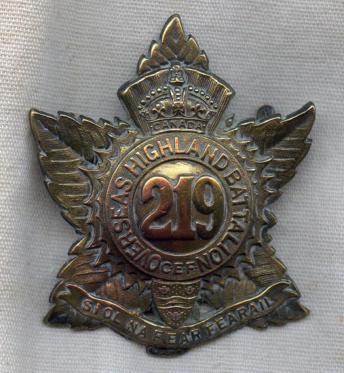
copyright © Wartime Heritage Association
Website hosting courtesy of Register.com - a web.com company
Wartime Heritage
ASSOCIATION
219th Battalion
1916 -1918
Based in Aldershot, Nova Scotia, the 219 Battalion began recruiting
in
early 1916 throughout Nova Scotia. Sailing from Halifax on
October 13, 1916, to England on RMS Olympic, the battalion arrived
in
Liverpool England on October 19th and was based at Witney Camp
and then Camp Bramshott.
Bramshott Military Camp, often simplified to Camp Bramshott, was a
temporary army camp set up on Bramshott Common, Surrey,
England during both the First and Second World Wars. Camp
Bramshott was one of three three facilities in the Aldershot
Command area established by the Canadian Army; the others being
Bordon and Witley.
The 219th battalion was absorbed into the 17th Reserve Battalion
on January 23, 1917, and a number of men were transferred to the
85th Battalion.
The 85th Battalion departed Witney Camp on February 10, 1917 for
Folkstone in Kent for departure to France on the SS London at
10:30 am the same day.
The 85th Battalion (Nova Scotia Highlanders) was one of the four battalions assigned to the 12th Brigade, part of the 4th
Canadian Division that joined the Canadian Corps in October 1916. The Division served in France and Flanders thereafter
until the Armistice.
The Division participated in the assault on Vimy Ridge, and took the left flank of the Canadian Corps on April 9, 1917.
Fighting on the 4th Division front led to heavy casualties, and some German positions managed to hold out from the 4th
Division for three days.
The Division participated in the battle of Hill 70 in Aug 1917 with Passchendaele following in mid-October, and into
November.
The 4th Division, including the 85th Battalion engaged in the battle of Amiens between the 8th and 11th of August 1918.
On the morning of August 8th the battle began in dense fog at 4:20 am. In the first phase, the British 18th (Eastern) and 58th
(2/1st London), the Australian 2nd and 3rd, and the Canadian 1st, 2nd and 3rd Divisions advanced against the German lines.
Parts of the American 33rd Division supported the British attackers north of the Somme.
The attackers captured the first German position, advancing about 3 km In the centre, supporting units following the leading
divisions attacked the second objective a further 3 km.
Australian units reached their first objectives by 7:10 am, and by 8:20 am, the Australian 4th and 5th and the Canadian 4th
Divisions passed through the initial breach in the German lines.
The third phase of the attack was assigned to infantry-carrying Mark V tanks. However, the infantry was able to carry out
this final step unaided. The Allies penetrated well to the rear of the German defences and cavalry now continued the
advance, one brigade in the Australian sector and two cavalry divisions in the Canadian sector. RAF and armoured car fire
kept the retreating Germans from rallying.
The Canadian and Australian forces in the center advanced quickly, pushing the line 4.8 km forward from its starting point by
11:00 am. A gap 24 km long was punched in the German line south of the Somme by the end of the day.
The British Fourth Army took 13,000 prisoners while the French captured a further 3,000. Total German losses were
estimated to be 30,000 on 8 August. The Fourth Army's casualties, British, Australian and Canadian infantry, were
approximately 8,800, exclusive of tank and air losses and those of their French allies.
The German general Erich Ludendorff described the first day of Amiens as the "Schwarzer Tag des deutschen Heeres" ("the
black day of the German Army"), because the morale of the German troops had sunk to the point where large numbers of
troops began to capitulate. The Allied forces pushed, on average, 11 km into enemy territory by the end of the day. The
Canadians gained 13 km, Australians 11 km, British 23.2 km, and the French 8.0 km.
The Battle of Amiens was the beginning of the last 100 days of World War I.
219th Battalion
1916 -1918



- World War I - Menu
- WWI Stories and Articles
- Photos - Yarmouth Soldiers
- Selection of World War I Songs
- WWI Casualties of Yarmouth, NS
- Those Who Served - Yarmouth, NS
- WWI Casualties Digby Co. NS
- WWI Casualties Shelburne Co. NS
- Merchant Mariners (1915) Yarmouth, NS
- Canadian Forestry Corps - Non Yarmouth Birth/Residence Enlistments
- US Draft Registry - Yarmouth NS Born


- World War II - Menu
- WWII Stories and Articles
- Telegraphist Air Gunners
- WWII Casualties of Nova Scotia
- US Casualties with NS Connection
- Far East/Pacific Casualties with NS Connection
- Merchant Navy Casualties Nova Scotia
- Nova Scotia WWII Casualties Holten Canadian War Cemetery
- D-Day Casualties - Nova Scotia
- CANLOAN Program Casualties - Nova Scotia
- Battle of the Bulge Casualties - Nova Scotia
- WWII Casualties Yarmouth NS
- Yarmouth Casualties - RCAF RAF Canadian Army WWII
- Yarmouth Co., Marriages WWII
- Casualties Non-Born/Residents with Connection to Yarmouth Co., Nova Scotia.
- WWII Casualties Digby Co., NS
- Non-Nova Scotian WWII Casualties Buried in Nova Scotia
- WWII RCAF Casualties Aged 16-18
- Brothers/Sisters Who Served - World War II














